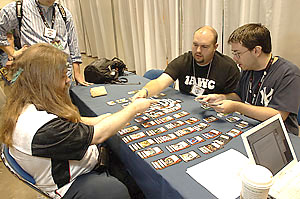 “Depressed yesterday, but pumped today!” was what Peter Sundholm said when asked how he felt about the weekend, and the rest of this star-studded team was sporting the same attitude. Shane Wiggans, a member of TAWC and former PC Top 8 competitor, pointed out that the three of them were the only players from their respective teams that had not made Day 2 in the Pro Circuit. Michael Dalton and Peter Sundholm, veterans of FTN, are the Vs. heavyweights that make up the other two thirds of Team Falling Down.
“Depressed yesterday, but pumped today!” was what Peter Sundholm said when asked how he felt about the weekend, and the rest of this star-studded team was sporting the same attitude. Shane Wiggans, a member of TAWC and former PC Top 8 competitor, pointed out that the three of them were the only players from their respective teams that had not made Day 2 in the Pro Circuit. Michael Dalton and Peter Sundholm, veterans of FTN, are the Vs. heavyweights that make up the other two thirds of Team Falling Down.
The first thing they did when they sat down was to spread out the cards by affiliations and drops, taking up the entire table in the process. The deck that jumped out at them before anything else was a Villains United deck. They decided against the two Coercion cards that they cracked, due to the fact that they would be able to play a straight Villains United deck with the strong pool they opened.
Sundholm didn’t feel that they had three strong decks, instead suggesting that they play two good decks, and run a third deck that wasn’t as strong, hoping to avoid watering down all three decks (and their chances of winning today) in the process. Their VU deck looked solid in its own right, and the next possibility they were looking at was Checkmate/JSA, using the powerful effects of the two Terry Sloane ◊ Mr. Terrific cards they opened in combination with Kate Spencer ◊ Manhunter to be able to make some massive attacks up the curve. This didn’t even take into account the two T-Spheres at their disposal. They worked their way up the rest of the curve, taking note of Richard Tyler ◊ Hourman and Hourman III ◊ Hourman as two of the highlights of the deck, and opting to come back to the deck after the third had been decided upon.
The lack of 2-drops seemed like a problem for them, since they only opened nine overall. To solve this problem, they removed the Checkmate cards from the JSA deck in an effort to fill in the gaps of the third deck, deciding to run an almost-straight JSA deck as their second deck (using two Blue Devil, Dan Cassidy cards to fill in the gap at that spot).
One card they had been worrying over was Ahmed Samsarra. They didn’t want to throw away games due to random KO effects that might be played against them, but they also wanted to harness the power he offered. They decided that if they were already playing a sub-par third deck, they would be able to run the Ahmed gamble there. It meant that they might lose a few games due to it, but they also might win more than they expected to with a deck they had relegated to the worst in their pool. Therefore, they would be running a Shadowpact/Checkmate deck as their final deck.
With the last deck completed, they went back to filling in the holes in their two power decks. As they laid out the generic plot twists, they decided to split up pairs of some of the most powerful twists in the format—Thanagarian Invasion, I Still Hate Magic!, Magical Lobotomy, and Burning Gaze—with one copy of each going in both decks. The JSA deck received a Revitalize and Epic Battle to round it out, finishing off the last two decks.
A notable cut in the last deck was the Grand Gesture, a card that some people consider one of the best reasons to play Villains United. They cited that there weren’t many small characters, and they were already playing two other bounce effects: No Mercy and Baddest of the Bad. When asked why they hadn’t included Fiddler to use as a free character they could play and return to their hand to fuel all the effects, Wiggans explained that the Fiddler tricks might be a little too “cute” and take up space in an otherwise tight-laced deck as far as characters go. Another cut in their pool I asked them about was the Deflection they placed in the unplayed pile early on, a card many people consider to be one of the premier defensive cards in the set. All of them agreed that the decks it would have gone into were more aggressive, and they wanted to commit to that strategy instead of pulling themselves in opposite directions.
With the decks settled, Sundholm took the low-power Shadowpact/Checkmate deck due to his preference of playing Shadowpact. Dalton and Wiggans took the high-power decks for themselves, hoping that their gamble would pay off and they could add a Team $10K trophy to each of their long lists of accomplishments.